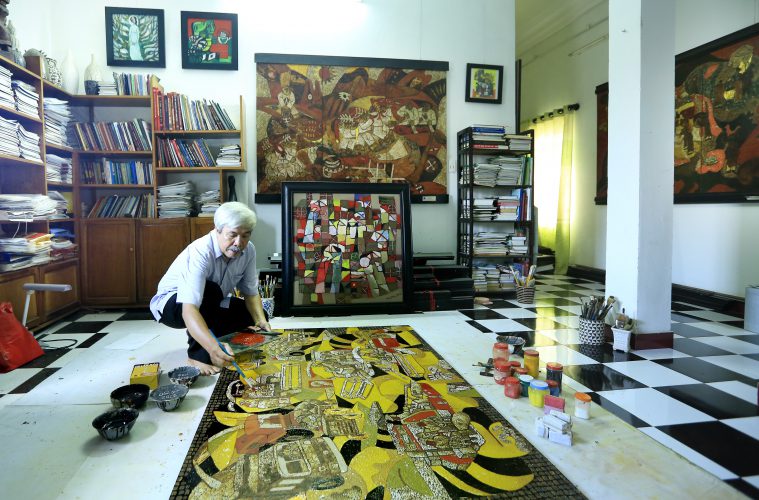Memories of artist Trinh Hoang Tan – winner of the State Prize in the fine arts field in Quang Tri Province
My hometown is Quang Tri, which in the war time was often called as “the land of fire”. In my youth, I wasn’t really aware of my ability for painting. It wasn’t until 1980, when I joined the 342nd Army Division, that I had the opportunity to touch colors. My initial drawings were on the unit’s wall newspapers, and later, I was transferred to the Cultural House of Division F342, where I began painting propaganda works. Over time, my passion for painting grew. After being discharged from the Army in 1984, I shifted to work at the Tan Lam Pepper Cooperative in Quang Tri Province and after 3 years was sent to study at the Hue University of Fine Arts. My family didn’t discourage it, they saw it as my passion and desire. My parents encouraged me to pursue a respected profession like painting, especially for those with genuine talent.
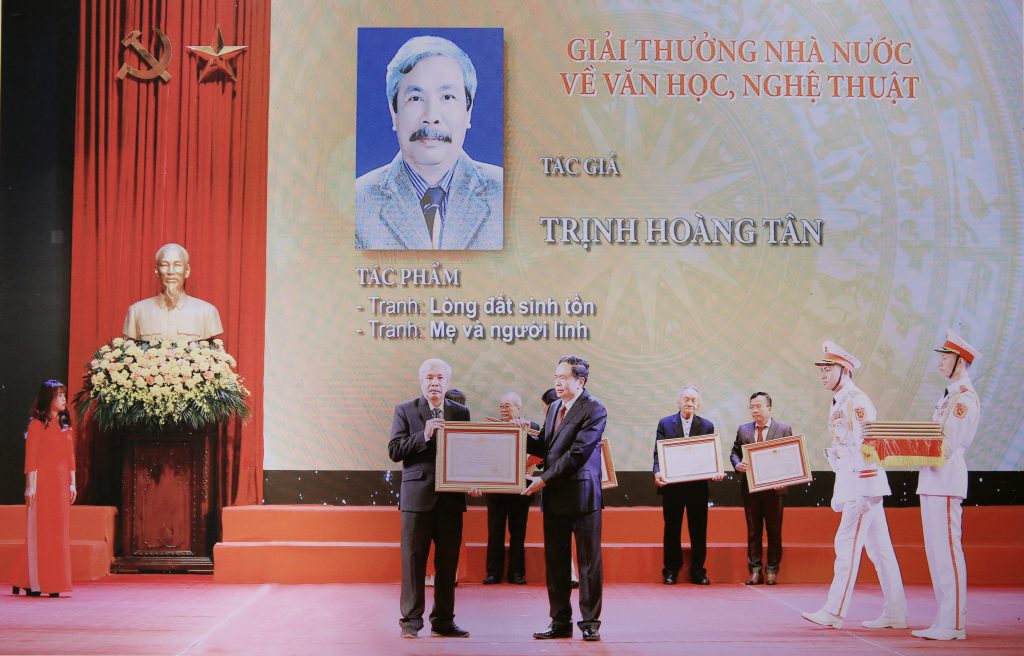
Artist Trịnh Hoàng Tân receiving the State Prize from Tran Thanh Man, a member of the Politburo and the Standing Vice Chairman of the National Assembly. May 19, 2023, Opera House, Hanoi
It wasn’t until my second year of university that I created my first meaningful painting using the technique of powder color. I remember it was titled “People and Masks.” (1988). The theme was a masquerade festival, with characters wearing a variety of amusing masks, creating a light and entertaining atmosphere. The festival costumes were diverse and captivating.
In my artistic journey, there have been many memorable experiences. In 1992, after graduating, I returned to work at the Tan Lam Pepper Cooperative. During my studies, I created several paintings, and after graduation, I had the opportunity to continue creating, resulting in a considerable number of paintings. At that time, the Head of the Quang Tri Fine Arts Association, artist Nguyen Huu Song (The Ha), along with photographer Sy So, Deputy Secretary-General of the Literature and Arts Association of Quang Tri Province (now referred to as Vice Chairman), visited my home to view the paintings. They decided to organize an exhibition for me in Dong Ha. While transporting the paintings from Tan Lam to Dong Ha, the vehicle had an accident. Fortunately, neither the people nor the paintings were harmed. After the exhibition, I was admitted as a member of the Literature and Arts Association of Quang Tri.
I have been active in the field of art for 39 years. Solo exhibitions used to be an activity reserved for those with financial means. However, times are changing, and solo exhibitions are becoming more common, especially as art galleries expand, and community-based activities diversify. Consequently, it’s not only renowned artists, celebrities, and experts who organize exhibitions; many other organizations and individuals have also joined the trend.
I haven’t had many solo exhibitions due to various factors, with financial constraints being the most challenging. In 1992, the first solo exhibition was organized by the Literature and Arts Association of Quang Tri Province. In 1994, I participated in a group exhibition with four artists in Hanoi, which was highly successful. All the paintings I displayed were sold at the Exhibition Hall 16 Ngo Quyen, Hanoi. In 1995, I registered for another solo exhibition in Hanoi with 50 entirely new artworks, and the results exceeded expectations.
From April 1993 to November 1998, I was transferred to the Department of Culture and Information in Cam Lo District, Quang Tri Province. In December 1998, due to the mission’s requirement for an artist to manage the fine arts and photography tasks, I was transferred to the provincial level under the Department of Culture and Information (now the Department of Culture, Sports, and Tourism) and held that position until my retirement.
Each artwork is a result of the artist’s artistic dedication, as it is a place for the author to express their deepest emotions, sincerest aspirations, and most intense passions. During my time managing fine arts, I accumulated a wealth of knowledge about art, contributing to the creation of lacquer paintings. Two lacquer artworks, “Survival Instinct of the Earth” created in 1998 and “Mother and Soldier” created in 2014, were later awarded the State Prize.
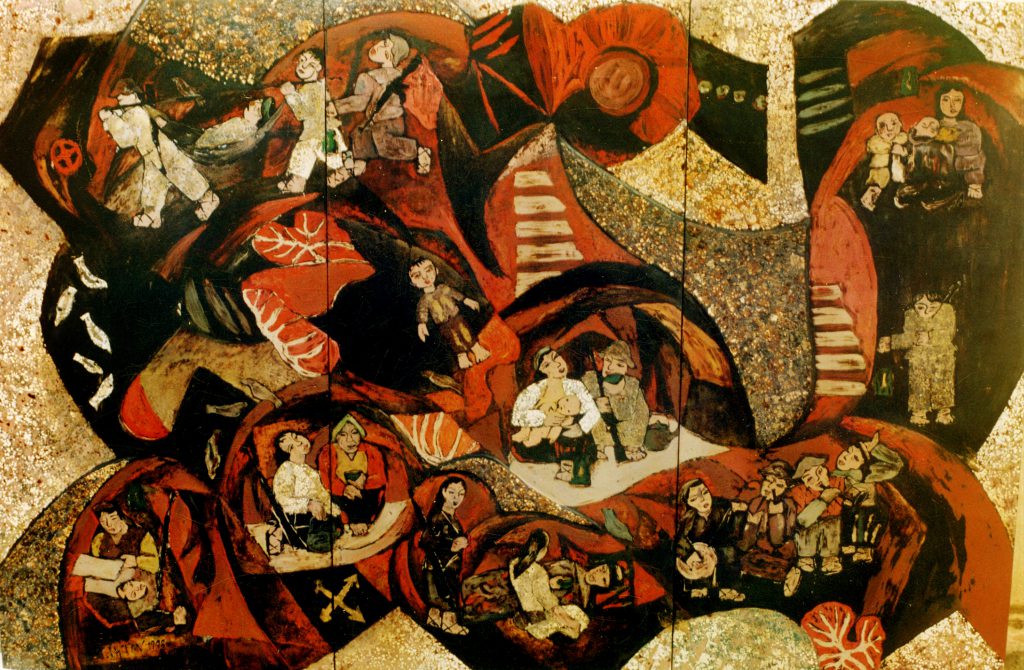
I have been a member of the Vietnam Fine Arts Association since 1993. I received the news of the State Prize from the Vietnam Fine Arts Association office, as that is where I submitted my dossier upon the recommendation of the specialized association. Emotions overwhelmed me when I found out that my lacquer paintings “Survival Instinct of the Earth” (Lòng đất sinh tồn) created in 1998 and “Mother and Soldier” (Mẹ và người lính) (2014) had passed through three levels of evaluation (at the grassroots level of the Vietnam Fine Arts Association, the State-level Professional Council, and the State-level Council). This is the state’s recognition of the artistic value and ideological content of the author and the works.
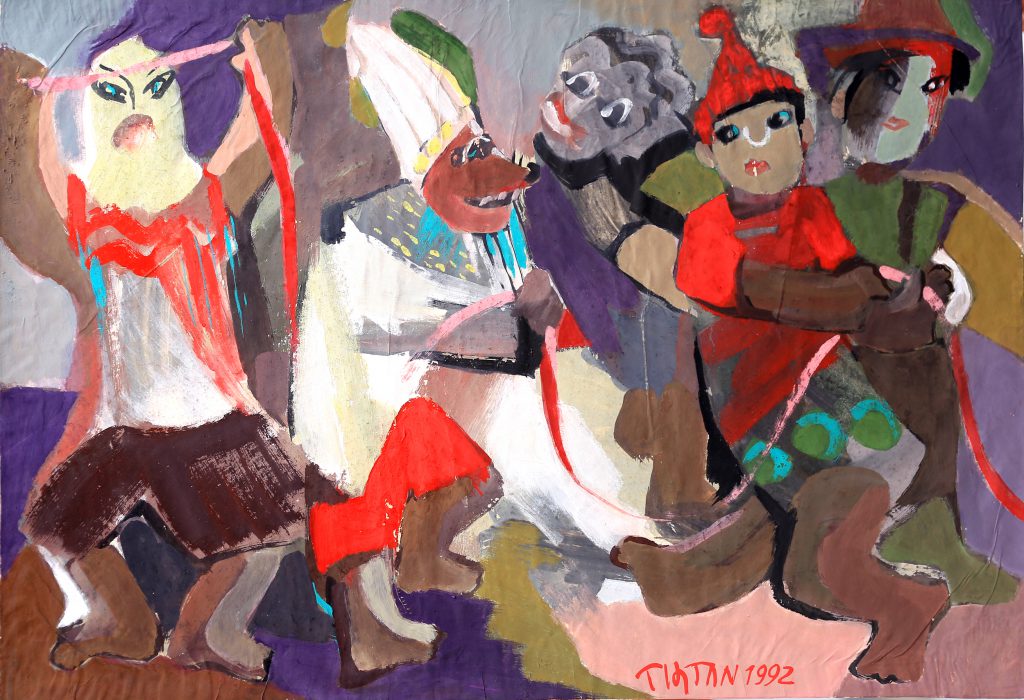
I believe that to create genuine works, an artist must immerse themselves in life, connect with people with a wholehearted and sensitive heart, nurturing and cherishing inspiration with a desire for creativity. Only when an artist truly lives amid life, passionately engages with and desires to integrate into life, can they produce truly valuable paintings. On the challenging path of art, an artist must overcome all difficulties to steadfastly pursue and strive to reach the ultimate goal of their chosen profession, dedicating themselves to their era with a strong sense of self-determination.
Being an artist who was awarded the State Prize makes me feel the need to exert even more effort, not for fame but as a responsibility of a creative artist to transcend the confines of their time.
About the painting “Hau Dong Heritage” (Lacquer, 120cm x 180cm) which was awarded the A Prize (the Provincial Literature and Arts Award in Quang Tri Province, 2019)
To create the “Hau Dong Heritage,” I had to attend many Hau Dong ceremonies in Thua Thien Hue Province, documenting the compositions, specific Hau Dong gestures, costumes, and ritual offerings. All the research related to creating this artwork was done very early. I started field sketching in 2017, detailing each part and necessary detail. In 2018, I began finalizing the sketches and completed the artwork in 2019.
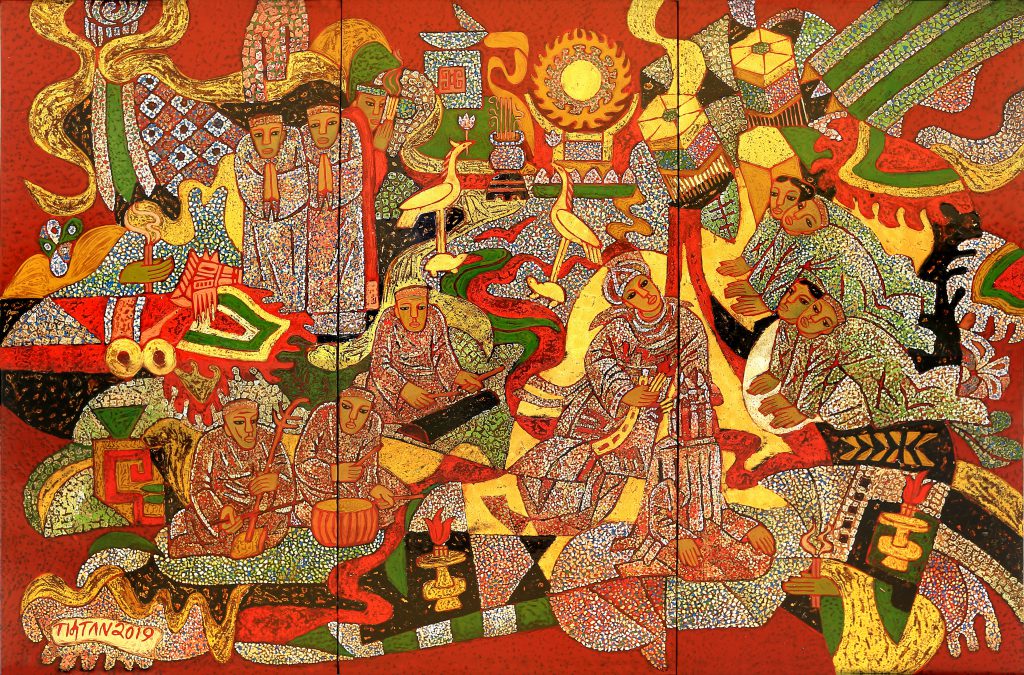
UNESCO has honored intangible cultural heritage as the representative of humanity’s cultural heritage. It is true, and I believe this is the success of innovation in the field of cultural arts. Of course, along with that are the creative ideas of the people as well as the enthusiastic support from various levels of government. Regarding Hau Dong, a form of religious and cultural practice contributing to the intangible heritage of the Three Mothers Worship, it has, at times, been considered superstitious or divisive for subjective and objective reasons. On a subjective level, this art form has been misused for fortune-telling or other superstitious activities. On the other hand, there have been times when our perspective on this cultural and religious phenomenon was biased, strict, and lacked filtration.
I chose Hau Dong as the theme for my creation because of these reasons. I want to promote this topic widely and deeply.
The painting recreates the images of characters in Hau Dong ceremonies, including the medium, costumed disciples, musicians, artists, and the bronze pillars – those who contribute to preserving and promoting the beauty and purity of the Three Mothers Worship ceremony of the Vietnamese people in both daily life and on the artistic stage. The main character is the medium performing rituals, dancing, bestowing blessings, and delivering prophecies through traditional singing and music with hands clasping incense, gently swaying, alongside costumed disciples solemnly and respectfully dressed.
I dedicated my utmost effort to convey the message of patriotic ideology that has been ritualized and spiritualized, bearing the vibrant imprint of the Vietnamese people, intimately connected with the roots and history of the nation, born from the people’s desire for favorable weather, harmony, and a prosperous life.
To me, an artist not only directs the human soul towards the beautiful, moral and true, but also helps individuals refine themselves, becoming more perfect, more compassionate, and more beautiful each day. In the process of creating this painting, my emotions were always a combination of sense of responsibility, sincere dedication, and a fervent desire to create a challenging theme.
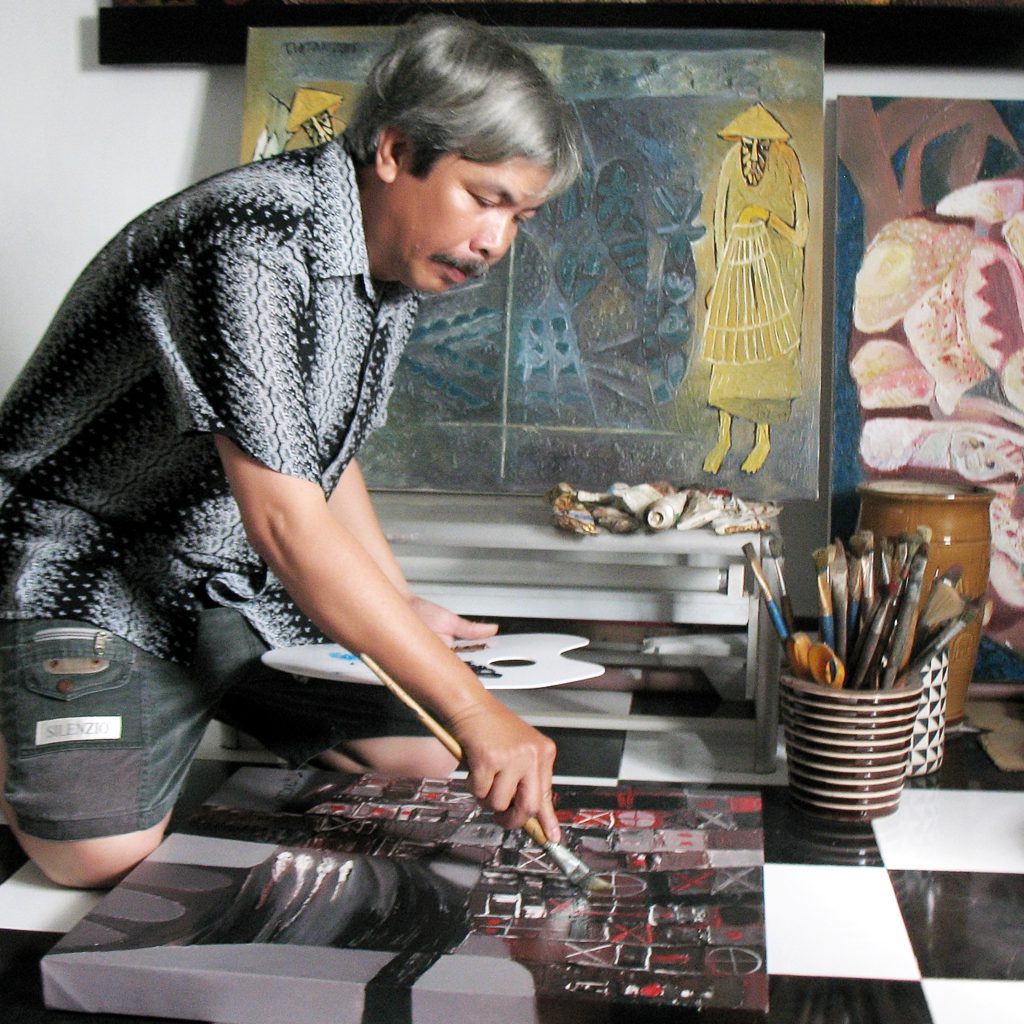
In addition to the lacquer painting “Hau Dong Heritage,” I have created several lacquer paintings that strongly reflect the cultural identity of the ethnic community, such as “Hope” (2001), “Cau Ngu Festival Year of the Rooster” (2005), “Village Festival in January” (2007), “Fishing Bridge” (2008), “Confluence of the Mekong Melody” (2010), and “Connecting Heritage” (recently, 2023)
Extract from interview conducted by Huong Quynh

